#early. early wbw.
Note
Hello there, and a happy [early] Worldbuilding Wednesday!
Reading through your OC intros, I'm curious about the relationship past and present between the KIN Navy and the Marines. Are they separate services, or is the latter a subsection of the former? What are the duties of a Marine?
Hi! Thanks for asking! Happy early Worldbuilding Wednesday to you too!
While in the modern day we usually associate the "Marine Corps" with a branch of seaborne combat forces, it is not so with the True Kondrian Empire. Their whole military doctrine is extremely slow to change and their version of a marine corps is still that which was typical of the Age of Sail.
In those days, a marine was mostly a type of military policeman. Marines were expected to maintain discipline and order on a ship and were usually discouraged from fraternizing with sailors. While they also fought in and against boarding parties in some battles, this was not their primary function. While other nations in the world began updating their marines to our more modern expectations, the Kondrians' Marine Corps remained as a police and boarding force.
Organizationally, the Kondrian Imperial Navy Marine Corps is heavily dependent on the Kondrian Imperial Navy. Units are organized via ships, although their rank structure follows that of the Kondrian Imperial Army.
For reference, here's the rank structure of the Navy:
Admiralty - First Admiral, Admiral, Midadmiral, Rearadmiral.
Captains - Captain, Midcaptain, Rearcaptain
Seamasters - Commander, Shipperson, Midshipperson
Sailors - Rearshipperson, Able Sailor, Sailor, Apprentice Sailor, Recruit
Here's the rank structure of the Army and Marine Corps:
Marshals - Grand Marshal, Groupmarshal, Batterymarshal, Troopmarshal
Grand Unitmasters - Grand Groupmaster, Grand Batterymaster, Grand Troopmaster
Unitmasters - Groupmasters, Batterymaster, Troopmaster
Troopers - Sub-Troopmaster, Senior Trooper, Trooper, Junior Trooper, Recruit
In the Kondrian Imperial Army, a group was led by a Groupmaster and had 2 batteries/84 troopers and 6 unitmasters. In the Marine Corps, the average cruiser would have at least 1 group of marines aboard. On ships with more than 1 group, a Grand Troopmaster would be present to be in charge of all marines aboard and would be given the position of Ordermaster aboard the ship. If there was only 1 group, the title would fall on the Groupmaster.
The Kondrian Imperial Navy is also much more relaxed than the Marine Corps. Sailors were held to the lowest standard of nearly all military professions and had very little discipline (compared to other soldiers. Compared to a civilian they were still quite disciplined). To make up for this, the marines were expected to be extremely disciplined. However, all this really did was create a constant tug of war against the two forces that were---in the end---supposed to be working together.
All these different rank structures and expectations served to attempt to drive a wedge between sailors and marines. They were not expected to cooperate and their enmity would be a detriment to the True Kondrian Empire's war effort on the seas.
#worldbuilding#world building#exposition#lore#ranks#rank structures#worldbuilding wednesday#wbw asks#wbw#my first wbw!#early. early wbw.#elstre
1 note
·
View note
Text

Legends of Mourra ✧ An Encyclopedia
↳ The Âras is an antelope with many-branched, black horns of a material similar to ebony, and when the wind passes through them it creates a haunting musical sound. Its hide is dun coloured and striped with glimmering white. It is a peaceful creature, and ranges in size from that of the daintiest antelopes to as large as the hardy draft horses of Diara to, according to unsubstantiated rumours, as large as the largest trees of the mysterious Khadra Wood it calls its home. Indeed, many suspect its size changes according to its will. The Xyl do not hunt it, for it is considered a sacred animal.
Children are said to be lured into the forest’s depths by the music of its horns, and when they return—if they return—they’re always a little strange afterwards. In reality, the children that are found are returned home by the Xyl, who sedate them with a harmless elixir so they do not remember their journey, in order to keep the location and other details of Xyl settlements a secret from outsiders.
[Inspiration: the kudu, Shadhavar/Âras from the Wonders of Creation, the Forest Spirit of Princess Mononoke (1999), the white stag of Arthurian legend, megafauna, and this tumblr post by @iguanamouth]
original images via: Jack van Belzen on Unsplash
lofm taglist (open!): @poetinprose, @jellybeanswriting, @treesandwords, @sculpture-in-a-period-drama
#lofm.encyclopedia#writeblr wednesday#(only early bc ill be away wed....or late since i missed the last few wbw)#wbw#writeblr community#worldbuilding#lofm.wip#kaatiba.edits
18 notes
·
View notes
Text



old concept art for the final chapter of my reylo comic Return, which i will probably never finish. these are from early 2023 and the idea was to have either ben or rey be trapped inside some sort of portal in the WBW and have the other fight to rescue them so they could return to the land of the living, basically. I never got around to drafting the rest of the plot for that last chapter but i wanted ben to really come to terms with his desire to start a new life with rey in which he is the person he always was and not the person he wanted to be, as Ben Solo and not Kylo Ren. i have many other sketches/illustrations in the vault and while it's unlikely the comic will ever be completed i'm still glad i took the plunge and made it bc i learned a lot along the way.
(the ben solo profile drawing with the butterflies in the top right of the last image is a sticker and available through my shop!)
#fantasticalleighs art#been a while since i posted art innit#reylo#reylo art#ben solo#ben solo lives#dyad#rey nobody#rey skywalker#reylo au#fantasticalleigh's art#sometimes i really do forget to let myself just be messy and not care about polishing things so much#which really sucks because yeah these are messy and jagged but i still really like them?
64 notes
·
View notes
Text
An unnecessary and in-depth analysis of magic colors used in TOH (Part 2):
Part 1 here
Purple:
Darius
Purple is associated with luxury, ambition, independence, mystery, arrogance, and inferiority
Darius is pretty much the embodiment of the color purple based on symbolism. He’s independent, he’s mysterious, he’s arrogant, he likes to live in luxury. He doesn’t act super ambitious but he is a Coven Head so we can assume he is somewhat. And the fact that he’s so competitive with Alador suggests that he may experience feelings of inferiority.
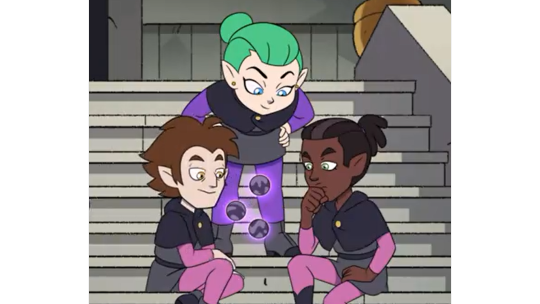
Magenta:
Amity, Alador, Tibbles, Gavin (possibly Kikimora and Malphas)
Magenta is associated with kindness, character, change, harmony, cooperation, and self respect but also impatience, arrogance and volatility.
Note: Kikimora and Malphas are listed as having purple magic on the wiki page, but it looks more magenta to me and I think that magenta makes more sense for them as well.
Impatience, arrogance and volatility are traits that are shared among these characters for the most part, though with Amity they’re mostly presented early in the show. The positive traits, consequently, have a lot of significance for Amity, who has gone through tremendous development and change over the course of the show. She’s become kinder and has learned to respect herself in a way that her parents couldn’t. She’s invited harmony into her life. If the show wasn’t cut short, I think we would have had a similar (smaller-scale) development for Alador and maybe even the other antagonists; at the very least Alador has taken initiative to change and better himself.
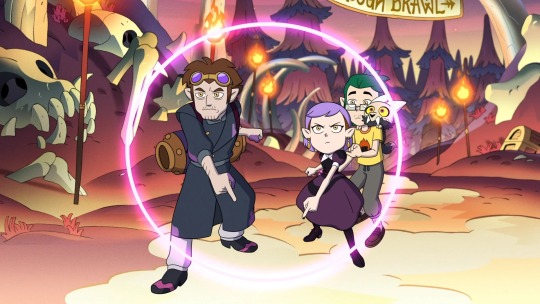
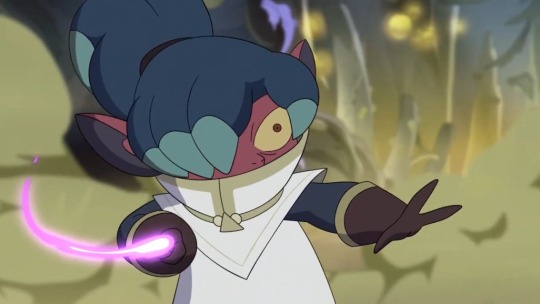
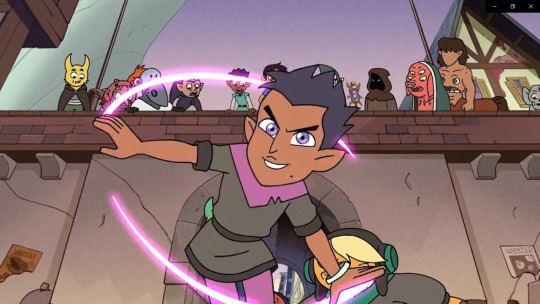
White:
Emperors Coven Scouts, Adegast, Detention Monitor, Oracle Teacher
White is associated with purity, innocence, perfection, safety, simplicity, illumination, emptiness, and unfriendliness
This one is interesting. For the Emperor’s Coven, since they are working for Belos, I can see their magic being sort of “sanitized”, void of their own creativity or free will. Similarly, for the teachers, maybe their magic is somewhat restricted when they’re on school grounds. They have to stick to the rules and regulations. For Adegast, maybe the white represents how his true nature/form was “illuminated” in WBW. Note: Jerbo is also listed using white on the wiki page but it actually looks like more of a white green to me, which makes more sense for him.

Yellow:
Eda, Mattholomule, Luz, Raine, Hunter (flapjack)
Yellow is associated with sunlight, positivity, intellect, creativity, and confidence. Some shades of yellow are also linked to magic and diversity. On the other hand, yellow can be a symbol of deceit, depression, or cowardice.
This one is fascinating to me. Yellow being associated with Luz makes perfect sense, her name literally means light and there’s so much symbolism in the show associating her with light. It also fits well for Eda, who is sort of the personification of magic and diversity, as well as sharing other traits with Luz. Eda and Raine are the only couple to share the same magic color and I think that was very much intentional, they are each other’s light. Hunter switching from red magic to yellow with flapjack must have significance as well. He goes from having every aspect of his life controlled by Belos, to finding a sense of autonomy and confidence in himself. Deceit, depression and cowardice are also all themes that recur for these characters throughout the show.

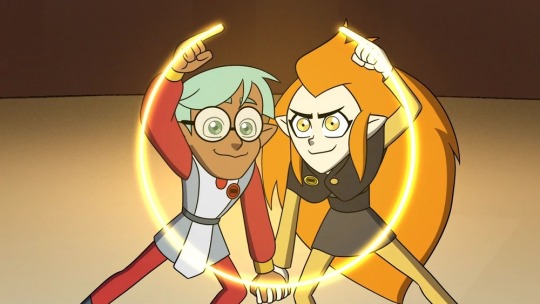
Now for the odd one out: Mattholomule. This is one of the things that got me interested in the colors in the first place. Matt having the same magic color as Luz, Eda and Hunter? Maybe he will have plot relevance in the next episode? Okay, most likely not. But a girl can dream. He’s definitely shown cowardice and deceit before. And he has a loud (overly-confident) personality. Maybe we will get some other hints of how the color fits him in WAD. Also curiously, Matt is one of the characters shown to use a different magic color at some point (more on that below)
Cyan:
Gus, Lilith, Edric, Emira, Adrian Graye, Titan Trappers, Keeper, Reviewnicorn
Cyan is associated with compassion, clarity, calmness, concentration, and communication. It can also signify narcissism, stress, secrecy, boastfulness. It’s also the opposite of red.
Many of the characters using this color are illusionists. At face value, concentration, clarity and communication are all important traits for illusionists to have. But I think for the twins, the color might also represent their connection and ability to see and understand each other. Likewise, Lilith’s color may be a symbol of her bond with Eda; her character development and how she grew to accept and understand her sister.

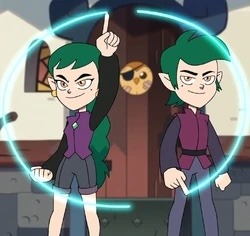
Adrian is a talented illusionist but his narcissism blinds him when it comes to really seeing and understanding others. The Reviewnicorn I could also see being somewhat boastful or narcissistic. And the Keeper, in addition to being compassionate and a skilled illusionist is definitely keeping some secrets. What about the Titan Trappers though? Is the blue a symbol of their secrecy? What do you guys think?
Finally, Gus. He really is the embodiment of this color as much as Darius is purple. He’s compassionate and understanding. He’s intuitive and able to see a lot of things that others might miss, even without magic. He’s able to get through to people and to see the good in them when others can’t. At the same time he can also be somewhat boastful and narcissistic himself at times. And we see how much he struggles with pressure and secrecy in particular.
Back to Matt for a minute, he’s seen in this image from the FTF credits using what looks to be cyan magic. Maybe it’s an accident or supposed to represent the use of illusion magic, but I like to think that perhaps it represents a connection to Gus. If you guys know of any other examples of characters switching colors, let me know!

#the owl house#toh#analysis#magic#symbolism#mattholomule#darius deamonne#amity blight#luz noceda#toh hunter#raine whispers#Gus porter#lilith clawthorne#edric blight#emira blight
264 notes
·
View notes
Note
Happy WBW!
What is the most dangerous animal in your setting that can actually be considered a pet (not like when people call tigers or lions pets)?
Hello! Happy WBW!!
Answering for Alium, my alternate dimension in TSP!
It's easily dragons. Like these things could easily kill you + we're just glad they can be domesticated.
Dragons do vary based on their species. In the early world building stages for this, but I have one dragon type for each existing power in Alium. The ultimate dragon (superstrength) is insanely strong, the speedster dragons are super fast, pyrokinetic dragons have the standard fire, etc.
Again this is early - but dragons have been pets since the beginning. Super dangerous, but friendly enough to be a pet. They are however not cheap pets - it's considered a high level of honor or status to care for one, since they have cultural significance being connected to the powers, but also because they watch over you in return.
Thanks again!
TSP intro
TSP tag list (ask to be +/-): @thepeculiarbird @illarian-rambling @televisionjester @finchwrites
#the secret portal#tsp#teaspoon#world building#world building wednesday#alium#writing blog#writers on tumblr#writing community#writers of tumblr#writing on tumblr#writeblr#writeblr community
12 notes
·
View notes
Text
Honestly, the biggest regret of my life was not screenshotting that post Dana made eons ago about Amity and Willow being girlfriends...
Because Ive been wondering for awhile if Caleb's/Evelyn's romance might be a recycled Lunter romance from the original draft of the story... because they have the same premise Lunter has, Evelyn shares similar physical features and themes with Luz [like with Eve and the serpent symbolism]. Oh right and theres that whole thing with Hunter being the only Grimwalker who looks the most like Caleb.
Hunter has been around since early bible days... so if I were to make a guess, she decided to swap out Hunter with Amity. She gave Amity Hunter's role in the first draft but instead of throwing out the Lunter romance completely it got repurposed into Caleb and Evelyn. And she also gave Amity's original role to Hunter as Willow's romantic partner... for some reason... a reason that i will never understand even if she sits me down and explains it to me...
But yeah, Caleb and Evelyn have always come off as characters who've been added into the story simply because Dana wanted to reuse an earlier concept. Which would explain why Evelyn's face is hidden but she shares physical features and themes with Luz.
WBW and SAI might also be a references to that original romance... even though SAI also foreshadows events surrounding King, Hunter, and Belos. NGL that heartbreak card is suspicious as fuck and will forever haunt me like Caleb's "ghost" haunts Philip.
#lunter#good luck scouring the internet for that ancient AmWillow info#if my assumption about Caleb/Evelyn being a recycled Lunter romance turns out to be true... then LMAO#Lunters deserve that poetic justice tbh
42 notes
·
View notes
Text
Live Action Clone Wars
I loved the first season of the Ahsoka series, especially all of the WBW stuff--I always need more Force lore in my life--but there's also something that's been pretty persistently on my mind since. The costuming on the flashbacks for the Clone Wars was great, especially for the ones that took place later in the timeline. And I'm far from the only person who was happy to finally see Hayden in this costume:

He looks wonderful! But it's also not quite right. I'll say upfront--I do not think they should have tried to do more digital de-aging, that's not at all the point. The point is that I've seen a lot of comments to the effect of "It's so cool to finally see what they'd look like together in live action!" And it absolutely is!
But--and there may be new info I just haven't seen--the only thing I've seen that puts a timeline on the early days of the war is the Wildspace novel (which I know is no longer canon). And according to it, the Battle of Christophsis took place only three weeks after the end of Attack of the Clones. Which means that on Christophsis, minus a change in hair and a mechno hand, they would have looked less like the picture above and more like this:
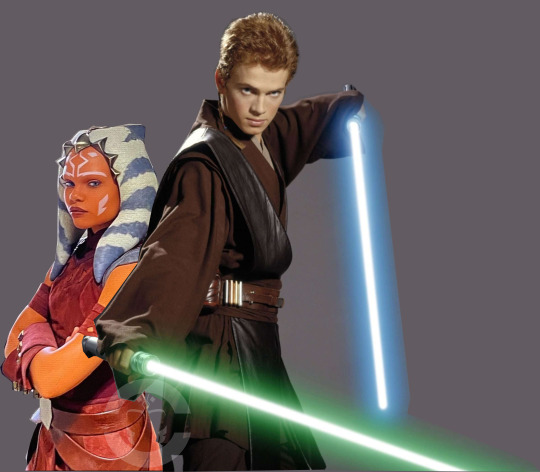
(Please excuse the quick and dirty nature of the 'shop.)
It's easy to forget, because Hayden is still pretty baby-faced, just how baby Anakin still was in the beginning days of the war, too. So I thought it would be good to put a visual together for it.
13 notes
·
View notes
Note
Happy WBW!
A silly question from a sleepy me: How should I go about spending a night outdoors in Valloroth? E.g. while travelling on foot. What sort of equipment do I need and what dangers, if any, can I expect?
hi Sam! happy WBW!
ohh man. i should know the answer to this off the top of my head given how much roaming around on the road in Valloroth Lucian and the gang do but i. do not.
Honestly in Invereid, where most of the main story in the first book is set, I didn’t put that many outdoor dangers. It’s a pretty temperate place in late spring/early summer, and I didn’t give Invereid many monsters roaming around. Would’ve made the place too crowded :p
In Invereid in summer you can camp pretty safely in a lot of places with Basic D&D Camp Gear. There probably are wild animals, but there aren’t that many that are huge threats, at least not that I’ve developed yet. One fun thing I do have developed is barometz, which are based on the vegetable lamb myth, only in Valloroth they are literally vegetable lambs:
A barometz sprouts, the plant growing a large gourd atop its thick stem until eventually it splits and the lamb emerges. The lamb remains attached via a stem-like umbilical cord and generally lives for a week or so before starting to age or rot. If left attached to the plant, a barometz will rot away to sludge within two weeks of emerging. If removed from the umbilical cord it can continue to live for only a few days before dying.
Barometz grow quickly and have short lifecycles. However, since they grow all year round, they make a perfect crop as they can be harvested repeatedly throughout the year.
They’re originally from Boudobrivvin and are an imported crop that took really well in Invereid, and are often found growing wild, and make the perfect food for travellers. The meat is very similar to flesh and blood sheep, so that’s free lamb chops every night if you want them.
As for other places, I have no idea as of yet. Mohaade - the parts of Mohaade Vren and Aliyne are from - are hot, dry desert regions, and I haven’t done my research into camping/travelling those yet, since no-one’s doing that in book one. You’d definitely need plenty of water, though. Oh, and Mohaade has basilisks:
A small and extremely venemous snake, whose venom is capable of paralysing instantly. Commonly found being thrown out of Mohaade households where they have crept in during the night to sleep.
Basilisks have a fearsome reputation outside of Mohaade—within the country they are a common nuisance. Their venom causes instant paralysis, but they are very small and quite stupid. A typical basilisk bite lasts no more than a few minutes.
Basilisks are typically reddish-brown in colour, with upper scales of dull maroon almost like dried blood, and a lighter, sandy-coloured underbelly. They have distinctive bright yellow eyes. Their heads appear oversized to their bodies.
So you have to remember to check your boots and such for those every morning.
Valloroth taglist: @cherrybombfangirlwrites @memento-morri-writes @foxboyclit @lawful-evil-novelist @at-thezenith @morganwriteblr @fayeiswriting @serenanymph (ask to be +/-)
#wbw asks#worldbuilding wednesday#fantasy worldbuilding#valloroth blogging#writeblr#i would put more monters in but it would bog down the plot to throw random encounters at the gang#i need ways to reference dangers without having them on the page#in a way that doesn't feel too tell-y#things to figure out in future drafts i guess
15 notes
·
View notes
Text
Swatili Woodworking: A Brief History
Hey folks! Writing this post starting Wednesday, which oughtta make this my obligatory Wbw resource. As you may tell, this has not been published on a Wednesday! Hope you all like it nonetheless.
Post-Finish Author's note: Holy cow I am not cut out for social history! Tried my best, and I can only hope you might find something interesting here!
@athenswrites @caxycreations @hessdalen-globe @theprissythumbelina @avrablake @enne-uni @pluvia-b @thatndginger @the-stray-storyteller
Lost Art, Stolen Art
The Art of the Sabto was at that kingdom's height was as great and grand as the product of any great state of such stature. In those olden days before their conquest - by the Commonwealth calendar some fifty years before that polity's own formation - the highest craft of the Sabto people was woodworking, which was for generations the adored symbol of kingdom, crown, and people.
Woodworking took on many forms, from the great city gates of Hurhamba with their hand-etched calligraphics stretching two storeys, to simple tokens or household furniture. The trade was a multi-generational one then, passed on within lineages of royally appointed Artisans who apprenticed for years in service to the court before admission into commercial guilds or private practice. Art was, thus, a closed off affair to the majority of the Sabto public, which gave individual pieces a special place within the social fabric. For newlyweds, for example, families who could afford to pooled their wealth into commissioning hand carved doors the couple's new nests.
The rich history of traditional Sabto woodcraft stretches into the mists of the past, by all accounts before their kingdom itself ever was. The near-golden age of Sabto state and culture, however, would not last for long.
------
Revival
------
The Kingdom of Sabto's conquest by the rising power that was then known as the Sultanate of Merkat was a tragedy in a thousand ways, and the wanton eradication of all that was good and great of the Sabto way of life ranked among them. For over a century under the yoke of the newly declared Fuhrati Empire, every temple, every palace, every sacred place which bore the memory of that peole was burned to ash in the wind, and peasant and artisan alike turned into the slave markets or traded as 'gifts' at the Emperor's whim. What small, flickering remnants still existed of those memories of old fled as far as they could, or found bare refuge in the 'stray Princedom' of Upepwani province.
Then, war came to the Fuhrati Empire.
The five-year long conflict fought between the United Commonwealth and the Fuhrati Empire was long, violent, and cruel, and under shell and gas much of the continent would lay in tatters when the Fuhrati state finally choked out its last breath. For the now-freed Sabto people, it was a time of immense remorse for those lost in the brutal violence meted out in the Empire's death throes, but also one of immense oppurtunity. Finally, it seemed, the time had come for the soul of the Sabto people to breath freely once again.
The Great Restoration was an affair as complex and multifaceted as the war that had preceded it, and a thousand stories could be told of those who lived through those early years of the young Republic of Swatili. Whether freed from bondage or descended from those who'd long ago found refuge in the province of Upepwani, those who felt themselves to be 'Sabto' could now make for themselves a life free from the now broken chains.
The revival of Sabto art would first grow its roots from Upepwani, once the last 'safe' haven for that culture. Its capital of Hurhamba, once the Kingdom of Sabto's greatest city, was now the elevated to the centre of the Republic, and from there the Sabto dormant enclave had slowly worked to preserve and accumulate what knowledge it could before it was lost to time. With their liberty born from victory, a veritable explosion of this pent up knowledge spread itself across the continent, a wave which could not be stopped.
The once forbidden works of every kind of Sabto artist from their Kingdom's height would be the first to come back to life, followed just as swiftly by the craft of a new generation born from the intervening century. For all that was remembered, much was forgotten, or more accurately lost to the acts of an Empire which sought the destruction of their knowledge as surely as it did the subjugation of their humanity. And yet enough remained for the living to make use of it, and the Sabto Revivalists would make for themselves an art and identity all their own, but whose roots would be well remembered.
------
From Small Things Grow Great Ones
------
The business of rebuilding a continent and creating a state left little time for art, yet there was plenty of Art all the same. The Woodworks of master artisans were studied intensely, but little of their methods survived the fall. Some in Upepwani, those descended from crafter stock, tried their hands at their ancestors' trades, but mimicry would not be enough.
One of the stranger elements to come from the Revivalist schools was the practice known as 'Miche', or 'Sapling'. It appears to have had its roots in the pupils of Mwajuma Tumaini, who upon their induction into her school were given a block of wood the size of a fist, by some tellings cut from Madam Tumaini's own sizeable palm orchard. From this they would be asked to cut anything at all they saw fit, with the strict instructions to work on it only once a day, for a minute at most. So many of Swatili's finest future woodworkers would come through her school, that this peculiar tradition would become as much a ritual to that craft as the honing of tools and the instruction of one's progeny.
Some, indeed many, who carry on the daily ritual have taken from it a moral lesson, often on the nature of art as a continuous process. Whatever Madam Tumaini's true reasons, her school and her teachings would carry on long after her death, and Miche was one of the most widely known. It created for itself a sort of social institution, a shared routine amongst these artists, and the best would claim to have kept at their first saplings to their deathbeds, making one final chip or cut to say farewell to their art. The vast human tapestry of Sabto art is as long as it is tragic, but woodworking, and Miche, have already made their place in it well known, threads in the cloth that will last for a long while yet in some form or another.
#worldbuilding#writeblr#worldbuilding wednesday#my worldbuilding#my writing#writing#my wips#writeblr stuff
8 notes
·
View notes
Note
Happy Worldbuilding Wednesday! What is archaeology like in your world?
Happy WBW, Charlie! Thank you for the question💜
In the Sunblessed Realm, where most of my WIPs are set, archaeology is non-existent. A quirk of the setting is that people live for as long as they have the will to live. Among other things, it leads to history not being that well preserved, because there are still people who remember the events first hand and the society doesn't feel the need to do that. It will change once the handful of people who lived at the time around the beginning of written history pass away - and so in The Truth Teller, we're following a historian helping out her friend at the Dept. of Archaeology and Anthropology. I'm having a lot of fun with the two of them drawing entirely wrong conclusions, because the truth is hard to believe :D
And in The Fulcrum, with the alien planet populated by birdfolk, there had been another sentient species that lived there previously, and left monumental buildings for the birdfolk to find. While this story is set before the invention of scientific method and archaeology as a field of study (it's sort of late-Bronze/early-Iron Age, depending where you go), any artefacts of the Ancients have religious significance and any surviving buildings are holy sites.
4 notes
·
View notes
Note
Happy WBW for this 😐! Where in your world is the equivalent to the American Midwest? Just the middle of bumfuck nowhere, with nothing going on. Everyone living there is kinda sad about it.
Thanks for the WBW ask!
(Side-note: as a non-American, hearing any part of the US described as "Bumfuck nowhere and everyone there is kinda sad about it" is really funny for some reason)
In Children of the Stars, I'd say it's probably any of the human Ceasefire territories, but specifically anywhere in the Sol system excluding Mars, Titan, and Callisto, which I know isn't technically the middle of nowhere (In fact, the ceasefire territories have one of the densest webs of FTL corridors in the Galaxy and the oldest in the Galactic fromtier) but it may as well be.
Venus is still being terraformed so there's a big ol' under construction sign there. Earth just feels like one big cultural museum and an ironic reminder that world peace came at the cost of a perpetual galactic civil war. Luna has Megacity Armstrong and a joint Imperial-Unionist boot camp, but that's about it. Most of the moons around the gas giants either house workers, the factories they work in, or the bored Solar Guard soldiers who try to look busy so that they don't get transferred to Callisto, or their purpose is to be the seat of government for those moons.
Like, the only real outliers to this are Callisto, where early gangs and citizen militias sort of merged together into a clan based warrior culture that even the Empire is too scared to try and police; Titan, where the Crimson Dawn uprising happened (Think Nazi's, then replace racism with a violent ideology of human supremacy and that's more or less what happened there) and most xeno tourists to Sol are still warned to stay away from over 50 years later; and Mars, which has become a symbol of freedom of expression, artistry, philosophy and intellectual works. Mars is also- by technicality, at least- not a human world, despite literally neighbouring our capital planet. It instead acts as an autonomously governed administrative capital for the entire Frontier Coalition, based out of the city of New Geneva.
Tl:Dr, the Heart of human space is the most dishearteningly boring place in the Galaxy.
4 notes
·
View notes
Note
Happy WBW! If you had to choose one of your OCs to cosplay as which one would it be?
Hey C, happy WBW (on Friday lol)!
Assuming I could actually pull it off (my cosplay skills are... far from expert lol), I'd probably have the most fun cosplaying as Qedlan from Ambition is a Lonely Tower (haven't posted anything from it here yet, currently on the backburner as i work on other WIPs).
For one, it would be hilarious. They're 6'5'' or thereabouts, and I am 5'2''; he's a ladar'in, which are basically giant bat-people from a parallel Earth; and he dresses like an early 2010's hipster. I'd need a frankly absurd amount of prosthetics for it, but it sounds so, so fun!
Thanks for the ask!
#writeblr asks#worldbuilding wednesday#wbw#saran answers#ambition is a lonely tower#somethingclevermahogony
4 notes
·
View notes
Note
Happy WBW!!
Does your story have any special animals, or beliefs about cryptids?
<3
Happy belayed WBW, and sorry for the very late answer. Since my mind is now back on Blood Night and refuses to worldbuild well, here we are.
And oh boy, I have a treat for you.
In the world of Blood Night we have some Witcher kind of shit going on with various monster, which are technically just strangely evolved animals after various dimensions collided into each other. (I think Witcher actually had a similar explanation)
One that appears a lot because they are just simple pests are Putrivines. Imagine angry turkey, with super shark beaks, who are active at late sunset/ early sunrise, with colorful back feathers, aggressive as fuck and thinking they are as big as a cow, hunting in groups.
My personal favorites are the huge riding wolves and the Talik, huge cats of the size of small horses you can also ride.
You could call the White Lady some sort of cryptid. She or it or whatever is no animal but more a spirit or something like this. There are various legends what she is, and she came to be, but they all share the same bottom line of where ever she appears the people in the area took too much from the earth and better take a run for their lives because she will make sure no one except animals will live in this area for a long time.
3 notes
·
View notes
Note
Happy WBW!
(Courtesy of my partner)
What is a piece of worldbuilding that you are really excited about but that you haven't been able to incorporate into your actual writing yet?
Sorry this one took a while, I had to break out the lore book!
I've got a lot of minor stuff I haven't been able to put in, but probably the biggest of these is the War of Conquest. Which, considering it's the reason modern Illaros Is the way it Is, is kind of a glaring oversight.
The War of Conquest kicked off about a thousand years ago as a result of various bad conditions in Janaz. This was before the establishment of the Janazi Confederacy, so the archipelago warred frequently and at the time, there were famines sweeping many islands, along with religious troubles. Many Janazi humans were hungry for something better. They wanted security and religious stability. It was one man, Nicklai Sayovski, who found a way to make that a reality.
Nicklai came up through the ranks of the Yunin military (a Janazi city-state at the time), eventually earning the rank of general. However, the corruption he saw in the upper ranks of the government and the overcrowding in his city only reinforced his sentiment that something drastic needed to be done to improve his people's quality of life. The course of action he decided on was, indeed, nothing but drastic.
After reaching out to several other influential figures (the politician Xiulin Haru, the diplomat Konguo Daiichi, the pirate Halicas Achmenos, the master mage Cardor Dular, the spy Altacoya Ceqliquetzal, the engineer Idan Sib Yamiz, and the generals Agita N'Jogu and Tua Durnan) Nicklai gathered not only an army, but a pack of homesteaders looking for a better life away from Janaz, and went out to conquer the continent of Iarl. From the humans' perspective, this conquest was justified. They were doing what they had to in order to help their own people, and they would be bringing the truth of Illarianism to the heathen masses.
The first place they conquered was the peaceful nation of Abrim, mostly composed of goblins and fenodyree. Because they surrendered early, Abrim was allowed to exist as a Republic satellite state in exchange for horses and siege machines. After that, the generals N'Jogu, Dular, and Durnan would prosecute a brutal campaign in the south of Iarl, pillaging and enslaving as they went. Up north, the politicians Daiichi and Haru played the elvish nations off of one another, promising each many things in exchange for religious conversion and military support. Ultimately, both Nabafyr and Skysheer knew that if they didn't ally with the Republic, their rival nation would, leading to them being crushed, so they each took the offer and converted to Illarianism. (Converted in name, at least)
The war in the south progressed pretty quickly after the elvish nations committed troops. Previously, the area had been made up of many, smaller nations that didn't have the might to stand up to such a massive force. It was after the brutal sack of Lanokos, after which General Durnan disappeared, that southern Iarl was officially declared Republic territory and settlers began to move in.
But the war wasn't over yet. There was still one major player on the Iarlan map that the Republic hadn't tangled with yet: The Dwarven Alliance.
Being an insular collection of city-states, the Alliance didn't care too much about what was happening in southern Iarl. However, one of the things the Republic had promised to Nabafyr and Skysheer was Alliance territory, knowing that if the elvish nations joined their cause, the rival Alliance never would. This began the longest stretch of the War of Conquest. Slowly and bloodily, the Alliance forces were pushed back from the Siegewall Mountains and into the poisoned Araunian desert, where they were forced to dig underground shelters to avoid the magical radiation. It took about ninety years to fully get the Alliance out of the mountains, and even in the modern day, border skirmishes are common.
After the war was officially declared over, the descendents of Nicklai's original team were each given a province to rule, with two other families being put in charge of the colonies the Republic siezed from the Alliance later in the war.
So, basically, everything in Illaros's current political climate can be traced back to the War of Conquest. The founding of the trade city Unity began as a refugee camp for southern Iarlans. The attitude of prejudice against non-humans and non-elves in the Republic can be traced back to the enslavement of that first generation of POWs, whose children were born free according to traditional human war laws, but were still subject to crushing poverty. The Alliance's xenophobia and precarious living situation in the Araunian desert is directly due to the actions taken 1000 years ago. Even the introduction of runic magic to Iarl and the formation of the Janazi Confederacy is because of the War of Conquest.
Anyways, here's a before and after map
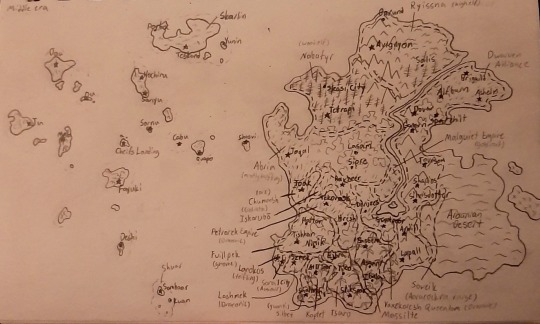
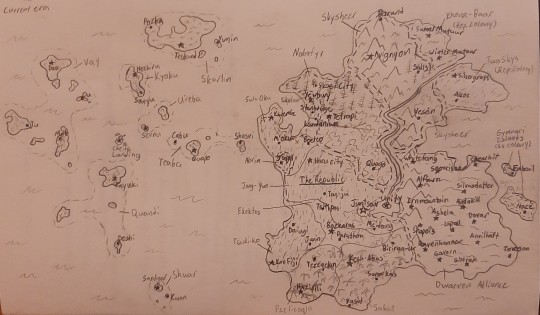
Thanks for the ask!
3 notes
·
View notes
Note
Happy WBW! What was Alium like in the past, before modern tech? Did they sort of follow Earth's agrarian to industrial revolution pipeline?
Happy WBW!
I'll say sort of. Since I'm focusing on the powers right now in world building, I'll get to direct effects on the world when I get there.
However, I can confirm that this is generally how society would develop overtime, but Alium would be quicker due to the powers advancing them and/or speeding things along. Superstrength and superspeed being the two most common and first that would, let's say, evolve would be extremely helpful in moving things along.
Healers being relatively early also means more advancements in medical knowledge, meaning a larger lifespan early on. A need to move to denser populations, a need for more industrialized construction. I now have moved metallokinesis to be a subpower of terrakinesis, which makes it more common, and means more metalworking.
This is what I have so far, so I hope it's satisfying
Thank you!
TSP intro
TSP tag list (ask to be +/-): @thepeculiarbird @illarian-rambling @televisionjester @finchwrites
#the secret portal#tsp#teaspoon#world building#world building wednesday#alium#writers on tumblr#writing community#writers of tumblr#writing on tumblr#writeblr#writeblr community
10 notes
·
View notes
Note
Happy WBW!
If your world has a main culture or religion, tell me about the people who DON'T believe in the same gods or culture. What groups are the minorities?
Hey friend! Thanks for the ask!
Incoming infodump because I spent sooooo much time on this oh my god.
WIPVII is basically just England in the early 1300s but slightly to the left. I did not want my story to fall into the trap of treating a pseudo-medieval England like a cultural and religious monolith because, of course, it gives the impression that real medieval England was a monolith and feeds into all sorts of bigoted revisionist history so...
I based the main religion heavily off of Catholicism because so many plot points in the story (around modesty, fidelity, marriage, women's roles etc.) rely on a very Christian-like status quo. The main culture is based off of the dominant Anglo-Norman culture in 1300s England. Of course, this makes it only fair that some other religions and cultures that also existed in 1300s England also get a shout out.
Ieuan is Cilfac and Udan, fictional cultures with similarities to Welsh and Jewish culture and religion respectively.
Uthman is multi-generational Cithic (which is the main ethnic group) but his ancestry is Idaluan, a fictional culture inspired by Muslim Al-Andalus (Spain). He still practices the religion of his ancestors too.
Henry has a grandmother from Lyzviria, similar to the Byzantine Empire (mainly Greek at this time). From her he gets his complexion, still pale-skinned because she came from royalty but with golden undertones rather than pink, and hair with dark, loose curls.
Matilda's father is from Para, a fictional city resembling Jerusalem. I never decided which religious group he belongs to but never comes up. Matilda was raised by her Cithic-Andovin mother, aunt, and uncle and practices the dominant religion.
There is also a more minor character (though arguably the most important after the pro- and antagonists themselves as far as plot is concerned) named Tamas of Mairan. Tamas is a seafaring mercenary/pirate who commands a multi-ethnic crew. He himself is from Torsia, which is inspired by Persia during Mongol conquest.
There are also a few other ethnicities that aren't dominant but... our modern lens see them all as white people whereas the distinctions are important to the people in this world.
Some context:
The Andovins are inspired by the Normans. The Pylts are inspired by the Anglo-Saxons (who, in 1333, had mostly integrated with the conquering Norman culture to become the Anglo-Normans, but some remote vestiges likely remained). The Cithic people are like to the Anglo-Normans, mostly common people with Piltish ancestry. The Cithic-Andovins are the upper-class, the rulers of Cithidy who are technically Cithic because they are from Cithidy but have much more in common, including the Andovaic language, with the Andovins than with the Cithics they rule over. There is also an ethnic group called the Diacs who live in northeastern Dian (it is from them the kingdom gets its name); this group is representative of the Celtic Bretons who came with the Normans to England in 1066. And I mentioned the Cilfacs already too.
This makes the two dominants groups the Cithics and the Cithic-Andovins. The Cithics are the majority group and make up the urban class of merchants, craftsmen, and clergy in most regions of Cithidy and Dian. The Cithic-Andovins are the ruling class that conquered Cithidy and Dian. They share a religion with the Cithics but not a language, and there are cultural differences. They are minority but comprise most of the noble families.
The Cilfacs and the Diacs follow a religion based on Celtic Christianity. The Pylts technically share a religion with the Cithics and Andovins, but they have some unique saints and traditions carried over from pagan times (although that was 600 years ago.)
As mentioned Ieuan is both Cilfac and Udan. He had a Cilfac parent, and a parent who was also Cilfac-Udan. In terms of his religious practices, he tries to honour both traditions in his own way.
Alan is Diac.
Wulfrith identifies more as Piltish than he does Cithic. Where he is from they still speak a dialect of the old Piltish tongue rather than the new Cithic one. The difference is like the difference between Old and Middle English (aka. Anglo-Norman). In fact, I cheated and just used Old English words for anything named in the Piltic language. Pilitish itself comes from pyll + cythu, the Old English words for inlet and homeland. Cithic is also derrived from cythu.
Though to be fair, I did that with more than just Old English. Wulfrith is an Anglo-Saxon name. Alan is a Breton one. Tamas is a name contemporary to 1300s Persia, and Uthman an Islamic name used in 1300s Al-Andalus. Ieuan is a Welsh name. Dian and Diac derrive from the Breton word diazac which means land that drains into a river. Cilfac is the Welsh word for creek.
so uh yeah... I hope you enjoyed my info dump!
8 notes
·
View notes